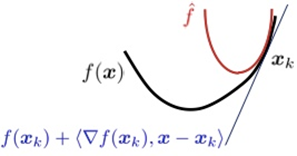[本文链接:http://www.cnblogs.com/breezedeus/p/3426757.html,转载请注明出处]
假设我们要求解以下的最小化问题:
( minlimits_x f(x) ) 。
如果( f(x) )可导,那么一个简单的方法是使用Gradient Descent (GD)方法,也即使用以下的式子进行迭代求解:
( x_{k+1} := x_{k} - alpha
abla f(x_{k}) ) 。
对GD的一种解释是( x_{k} )沿着当前目标函数的下降方向走一小段,只要步子足够小,总能保证得到 ( f(x_{k+1}) leq f(x_{k}) )。
如果(
abla f(x) )满足L-Lipschitz,即:
( ||
abla f(x') -
abla f(x)|| leq L ||x’ - x|| ),
那么我们可以在点( x_{k} )附近把( f(x) )近似为:
( hat{f}(x, x_k) doteq f(x_k) + langle
abla f(x_k), x - x_k
angle + frac{L}{2} ||x - x_k||^2 )。
把上面式子中各项重新排列下,可以得到:
显然( hat{f}(x, x_k) )的最小值在
( x_{k+1} = x_k - frac 1 L abla f(x_k) )
获得。所以,从这个角度上看的话,GD的每次迭代是在最小化原目标的一个二次近似函数。
在很多最小化问题中,我们往往会加入非光滑的惩罚项( g(x) ),比如常见的L1惩罚:( g(x) = ||x||_1 )。这个时候,GD就不好直接推广了。但上面的二次近似思想却可以推广到这种情况:
这就是所谓的proximal gradient descent(PGD)算法。只要给定( g(x) )时下面的最小化问题能容易地求解,PGD就能高效地使用:
比如( g(x) = ||x||_1 )时, ( ext{prox}_{mu g} (z))能够通过所谓的soft thresholding获得:
( ext{prox}_{mu g} (z) = ext{sign}(z) max{|z| - mu, 0} )。
[References]
[1] John Wright. Lecture III: Algorithms, 2013.


